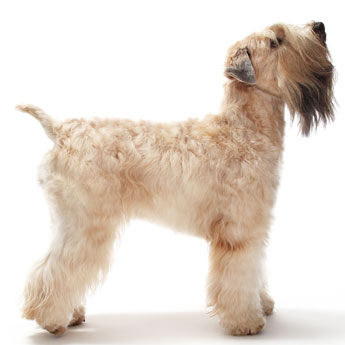The coat of a Wheaten Terrier when natural, is soft and silky. Is non-shedding so requires regular grooming to remove dead hair and to prevent matting. It is neither woolly nor wiry, and is loosely waved or curly. If curly, the coat has large, light and loose curls. The coat should not standoff, but flow and fall naturally. The coat is abundant all over the body and equally profuse on the head and legs. The length of leg coat should be sufficient to give good balance to the length of coat on the head and body. The color is wheaten, but youngsters may have dark markings, which should clear with maturity.
MAINTENANCE: Over trimming or styling is considered wrong. For the show ring, it is permissible to tidy the coat to give a neat outline. In Britain, this breed is shown in full coat, and in Ireland and elsewhere it is more heavily trimmed, but never to the extent of the Kerry Blue.
The Soft Coated Wheaten Terrier is a natural dog, and should appear as such. However, for the purpose of the show ring, the coat may be tidied up to present a neat outline, but the breed should not be clipped, stripped or styled.
The main differences between the U.K. and U.S. Wheatens are in the finish. The coat on the ears, for instance, may be left natural or the fringe trimmed off to accentuate their smallness, but they are not clipped so short as to appear shaved.
Secondly, thinning scissors are used to “tip” the coat (i.e., trim off the ends of the hair), as well as to thin it and to make the hair lie flat. All trimming should create a balanced look, so that no one part of the body is accentuated.
PROCEDURE
Equipment needed: Wide-toothed comb, straight scissors and thinning scissors.
Breed tip: A wide-toothed metal comb is recommended for the Wheaten coat when it comes to daily grooming, as a slicker or pin brush tends to split the coat ends and strips out new hair growth.
- Comb through with a wide-toothed comb to remove dead hairs and to ensure no tangles are present.
- Mats and tangles can be removed by parting them with the finger and thumb, and then teasing them with the end of the comb. If necessary, use a mat-splitter — with care. Alternatively, spray the coat with conditioner to ease combing.
- Bathe the dog in a quality natural shampoo, such as tea tree and lavender.
- Rinse well.
- Apply a quality conditioner to enhance the texture of the coat.
Comb through, after thoroughly towelling the coat, and leave it to dry naturally. Or, separate the hair and gently blow-dry to assist drying. Do not overblow, as this will destroy the natural wave of the coat. Make sure you blow-dry the coat in the direction it should lie, so the coat lies nicely and doesn’t appear overly fluffy. - Comb through the coat once more with a wide-toothed comb.
- The head is trimmed with thinners from the back of the eye to the neck, and from the top of the ear to the throat, leaving the beard forward-facing, and giving the head a rectangular shape. The top of the skull is slightly domed in the U.S.
- Eyelashes should remain intact as these help to hold the hair away from the eyes.
- The head is not clipped short for general purposes, but this is sometimes requested by pet owners.
- The ears are trimmed to a V-shape, following the contours of the ears.
- Thinning scissors can be used on the flap going upwards from the bottom of the ear to the head, leaving longer hair toward the head and shorter at the tips.
- Excess hair under the ears should be trimmed away with thinning scissors.
- Where trimmed, scissor the coat to the dog’s contours following the outline of the neck, body and legs, and keeping to a moderate length. Tipping the hair should be sufficient (“tipping” involves a light scissoring of the ends of the hair). Otherwise, use thinning scissors to remove unwanted hair. This hair should appear natural, rather than sculptured.
- The tuck-up line of the coat under the body is level at the elbow, sloping gently upwards towards the loin.
- Blend the leg hair to give a natural balance by snipping straggly hairs, following the contours of the stifle and hock. The front legs should look like columns.
- Check under the feet for excess hair and remove with scissors.
- Neaten around each foot.
- Tidy the tail to a neat outline. Trim underneath the tail to keep it clean and hygienic.
- The underside, belly and groin can be clipped with a No. 10 Oster on all pet dogs, for hygiene reasons.
- Check the dog’s nails, ears and teeth.

